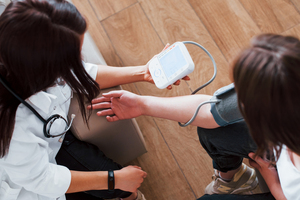Annual Physical Exams
in South Dakota
Own a clinic? Add your location.
Help patients book appointments with you on Solv. It's free!
0 instant-book locations
Hy-Vee Pharmacy
Hy-Vee Pharmacy
Sanford Clinic Acute Care
Sanford Clinic Acute Care
Hy-Vee Pharmacy
Hy-Vee Pharmacy
Sanford Clinic Occupational Medicine
Sanford Clinic Occupational Medicine
Sanford Clinic Acute Care
Sanford Clinic Acute Care
Avera Medical Group
Avera Medical Group
Sioux Falls, Urgent Care
Sioux Falls
Own a clinic? Add your location.
Help patients book appointments with you on Solv. It's free!
South Dakota Physical Exams
As part of a doctor's routine checkup, a physical examination is usually performed. Learn more about what happens during a physical exam to better prepare for your next medical appointment.
Physical examination
A physical examination is when a healthcare professional examines and studies your body to see if you have a physical health problem. The four components of a physical examination, according to the National Library of Medicine, are inspection, palpation, auscultation, and percussion (NLM).
During the examination, your doctor looks over your body for any issues, such as skin flaws. Palpation is the technique of feeling your body with your fingers or hands, such as when a doctor feels for a tumor or mass, according to the National Library of Medicine.
Auscultation is a method of listening to sounds, such as your heartbeat, by your doctor. Making noises, such as tapping on various body parts, is referred to as percussion. This is usually done to determine the size and consistency of your organs, as well as the presence or absence of fluids in specific places, according to the National Library of Medicine.
The purpose of an annual physical exam
According to the National Library of Medicine, an annual physical exam can help you discover and avoid health problems you may not be aware of.
An annual physical exam is used to screen for diseases like cancer and to see whether you're at risk for certain health problems like diabetes. A yearly physical checkup, according to the National Library of Medicine, helps you to stay current on vaccines and other preventative health treatments, as well as make smart lifestyle choices that benefit your general health. Another benefit of having a yearly physical examination is that you can communicate with your doctor at any time if you develop an illness or chronic disease.
How to prepare for a physical examination
According to the National Library of Medicine, being prepared for your appointment will help you make the most of your time with your doctor and avoid unnecessary follow-ups.
First, review your family's medical history and be prepared to discuss any inherited health concerns, such as high blood pressure, cancer, or diabetes. Your doctor may use this information to assess if you're at risk for these same health problems, according to the National Library of Medicine.
Check with the National Library of Medicine to discover if any general exams or immunizations are required. If you're not sure, call your doctor ahead of time to make sure you're dressed appropriately or to make special arrangements if you need to undergo specialized tests.
Finally, the National Library of Medicine recommends making a list of issues and questions to bring up at your meeting. If you've been suffering any new or different symptoms, for example, write them down so your doctor can evaluate you for any linked health issues.
How a physical examination is performed
The manner in which your physical exam is conducted is primarily governed by your gender and age, according to the National Library of Medicine, due to differences in anatomy and health problems that impact different age groups.
Male examination
Males between the ages of 18 and 39 have their height, weight, and body mass index (BMI) measured at every consultation, according to the National Library of Medicine. Males in this age group may be asked about mental health issues including depression, as well as their food, exercise, and substance use habits. It is possible to assess your blood pressure, cholesterol, diabetes, and heart disease.
Males aged 40 to 64 receive the same services as men aged 18 to 39, including colorectal cancer, lung cancer, prostate cancer, and osteoporosis screenings, according to the National Library of Medicine. Men in their sixties and seventies may also be questioned about their medications and whether or not they have fallen recently.
Female examination
Females between the ages of 18 and 39 will have their height, weight, and BMI checked at each visit. Females should have their blood pressure checked every one to two years, according to the National Library of Medicine, and cervical cancer screenings should begin at the age of 21. Females in this age group may get diabetes and cholesterol screenings as part of their routine medical examination.
Women between the ages of 40 and 64 receive all of the same services as younger women, including lung cancer, colorectal cancer, and osteoporosis screenings, according to the National Library of Medicine. Routine mammograms may be performed on women over the age of 65, and they may be asked about any medications they are taking.
Lab tests
Your doctor may order lab tests to confirm or rule out one or more disorders based on the results of your physical exam. Lab tests may be utilized as part of evaluations for illnesses such as colorectal cancer and cervical cancer, according to the National Library of Medicine.
Call your doctor ahead of time to find out if you'll be getting blood tests and what they'll entail so you can make the necessary arrangements.
Following up after a physical examination
Following your physical examination, you may be called if one of your screens or lab tests comes back positive or inconclusive. Your doctor will contact you in such circumstances to discuss treatment choices or to recommend additional tests and screening. Your doctor can tell you more about what to expect in terms of follow-up after your physical exam.
Physical Exam FAQs
What is a physical exam?
A physical exam is a procedure in which your doctor examines your body to see whether you have any health problems.
What happens at a physical for a woman?
A doctor will review a woman's medical history and perform the recommended screenings for her age group during a physical exam. According to the National Library of Medicine, she may also have her blood pressure and cholesterol levels examined, as well as have a conversation with her doctor about any new or existing health concerns.
Why are physical exams important?
Physical exams are crucial, according to the National Library of Medicine, since they can uncover health concerns that you may be unaware of and help you minimize your chance of developing future health problems such as osteoporosis or diabetes.
How long do exams take?
According to the National Library of Medicine, the length of time it takes for your doctor to do a physical exam is largely determined by the type and quantity of procedures and screenings that will be performed during your consultation. So that you can make the necessary arrangements, ask your doctor how long the exam will take.
What are common lab tests that can be ordered during a physical exam?
During a physical exam, your doctor may prescribe a Pap test, a blood glucose test for diabetes, a cholesterol test, a complete blood count, and a thyroid-stimulating hormone test, according to the National Library of Medicine. During your next appointment, your doctor can provide you more information about the lab tests that may be recommended for you.
What vital signs are taken during a physical?
According to the National Library of Medicine, vital signs are normally measured during an annual doctor visit because they alter with age, weight, activity level, and overall health. Blood pressure, temperature, pulse, and breathing rate are examples of vital indicators.
What questions should you ask your doctor during a physical?
You can learn more about your health and the activities you can take to address or avoid specific health problems by asking questions during your physical checkup. According to the National Library of Medicine, you should bring a list of questions and concerns about your health to your appointment, such as new symptoms you're experiencing and screens and tests you should undergo based on your age, gender, and family history.
Where can I find and book a physical exam in South Dakota?
Solv is the simplest and most convenient way to schedule a physical test. You may rest easy knowing your physical exam is being handled by a knowledgeable doctor thanks to Solv's database of just the highest-rated providers in your area. Visit Solv now to locate an urgent care clinic or a doctor who can offer physical exams near you.
Solv has strict sourcing guidelines and relies on peer-reviewed studies, academic research institutions, and medical associations. We avoid using tertiary references.
Related Searches
DOT Exam in South Dakota
Ear Wax Removal in South Dakota
Physical Exam in South Dakota
Sports Physicals in South Dakota
A1C Test in South Dakota
Allergy Testing in South Dakota
Basic Metabolic Panel in South Dakota
Blood Test in South Dakota
CMP Test in South Dakota
COVID-19 Antibody Test in South Dakota
Cholesterol Test in South Dakota
Glucose Test in South Dakota
Hepatitis test in South Dakota
Mono Test in South Dakota
Pregnancy Test in South Dakota
RSV Test in South Dakota
STD Testing in South Dakota
Strep Test in South Dakota
TB Test in South Dakota
Thyroid Test in South Dakota
Urinalysis in South Dakota
Vitamin D Test in South Dakota
Aetna Urgent Care
Blue Cross Blue Shield Urgent Care
Cigna Urgent Care
COVID-19
Flu
United Health Urgent Care
» All services in South DakotaEveryday Healthcare, Simplified
Expert advice to help you live your best life









